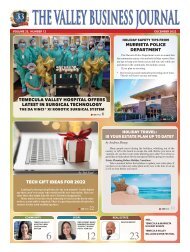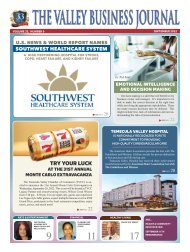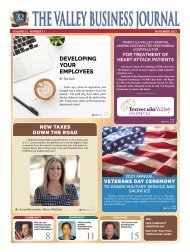VBJ February 19
Create successful ePaper yourself
Turn your PDF publications into a flip-book with our unique Google optimized e-Paper software.
THE VALLEY BUSINESS JOURNAL<br />
12 www.TheValleyBusinessJournal.com<br />
<strong>February</strong> 20<strong>19</strong><br />
How Will Tax Reform Impact Your<br />
Deductions and Credits This Tax Season?<br />
MONEY<br />
by<br />
Esther Phahla,<br />
CPA, CTC, MST<br />
With tax season here, chances<br />
are you are probably asking yourself<br />
which tax deductions and tax credits<br />
will you be able to claim for your<br />
2018 tax return, unless of course you<br />
did some tax planning before the end<br />
of 2018 and you have an idea of what<br />
to expect this tax season.<br />
Tax credits and tax deductions are<br />
said to be the most satisfying part of<br />
preparing your tax return, because they<br />
reduce your tax bill, and put money<br />
into your pockets. But they do this in<br />
different ways. First, let’s review the<br />
difference between a deduction and a<br />
credit.<br />
A Tax deduction: is used to decrease<br />
taxable income, thereby decreasing the<br />
amount of tax owed. They are calculated<br />
using your marginal tax bracket.<br />
For example, if Rose is in the 24% tax<br />
bracket, a $1,000 tax deduction will<br />
save her $240.<br />
A Tax Credit: is subtracted not from<br />
taxable income but directly from a<br />
person’s tax liability; thus it reduces<br />
taxes dollar for dollar. It could be refundable<br />
or non-refundable. Looking<br />
at the example with Rose above, a tax<br />
credit of $1,000 will lower her tax bill<br />
by $1,000.<br />
There are 2 types of Tax Deductions:<br />
Standard Deduction and Itemized<br />
Deductions. You can use one or the<br />
other but not both. It is generally recommended<br />
that you take the greater of<br />
the two unless special circumstances<br />
apply. Many taxpayers who itemized<br />
in the past will face a big question this<br />
year: whether is it still worth itemizing<br />
given the new higher standard<br />
deduction?<br />
1. Standard Deduction: is a set<br />
amount that ensures all taxpayers<br />
have at least some income that<br />
is not subject to federal tax (i.e.,<br />
tax-free). Even if you have no<br />
other qualifying deductions, the<br />
IRS lets you take this deduction<br />
and no-question about it. It varies<br />
according to your filing status.<br />
For 2018 tax returns the standard<br />
deduction has nearly doubled<br />
($12,000 for Single filers and<br />
Married filing separate, $24,000<br />
for Married filing jointly, $18,000<br />
for Head of household).<br />
2. Itemized Deductions: allow you to<br />
list qualified expenses on your tax<br />
return, the sum of which is used to<br />
lower your adjusted gross income,<br />
such as home mortgage interest on<br />
up to $750,000 of new home acquisition<br />
debt, state and local taxes<br />
up to $10,000, medical expenses<br />
over 7.5% of your adjusted gross<br />
income and charitable donations.<br />
Let’s recap a few of the common credits<br />
and deductions for 2018:<br />
1. Child tax credit: increased to<br />
$2,000 and a new credit of $500<br />
for non-children dependents was<br />
introduced.<br />
2. Credit for child care: up to $1,050<br />
for one child and $2,100 for 2+<br />
children.<br />
3. Earned Income Credit: up to<br />
$6,431 with 3+ children.<br />
4. Education credits: up to $2,500 for<br />
the American Opportunity Credit,<br />
up to $2,000 per return Lifetime<br />
Learning credit, up to $2,500 Student<br />
loan interest deduction.<br />
The following are eliminated:<br />
1. Exemptions: With the increase of<br />
the standard deduction, came the<br />
elimination of the exemptions.<br />
2. Unreimbursed employee expenses.<br />
3. Moving expenses: except for active<br />
duty military.<br />
Consult your Tax Advisor to make<br />
sure you are taking advantage of all<br />
the tax deductions and credits that are<br />
available to you.<br />
Esther Phahla is a Certified Public<br />
Accountant and Certified Tax<br />
Strategist in Temecula. She is the<br />
Best-Selling Author of tax planning<br />
books, “Why Didn’t My CPA Tell Me<br />
That” and “10 Most Expensive Tax<br />
Mistakes That Cost Business Owners<br />
Thousands”. She also holds a Masters<br />
of Science in Taxation. She can<br />
be reached at (951) 514-2652 or visit<br />
www.estherphahlacpa.com<br />
“ Tax credits and tax<br />
deductions are said<br />
to be the most satisfying<br />
part of preparing<br />
your tax return,<br />
because they reduce<br />
your tax bill, and put<br />
money into your<br />
pockets.

















